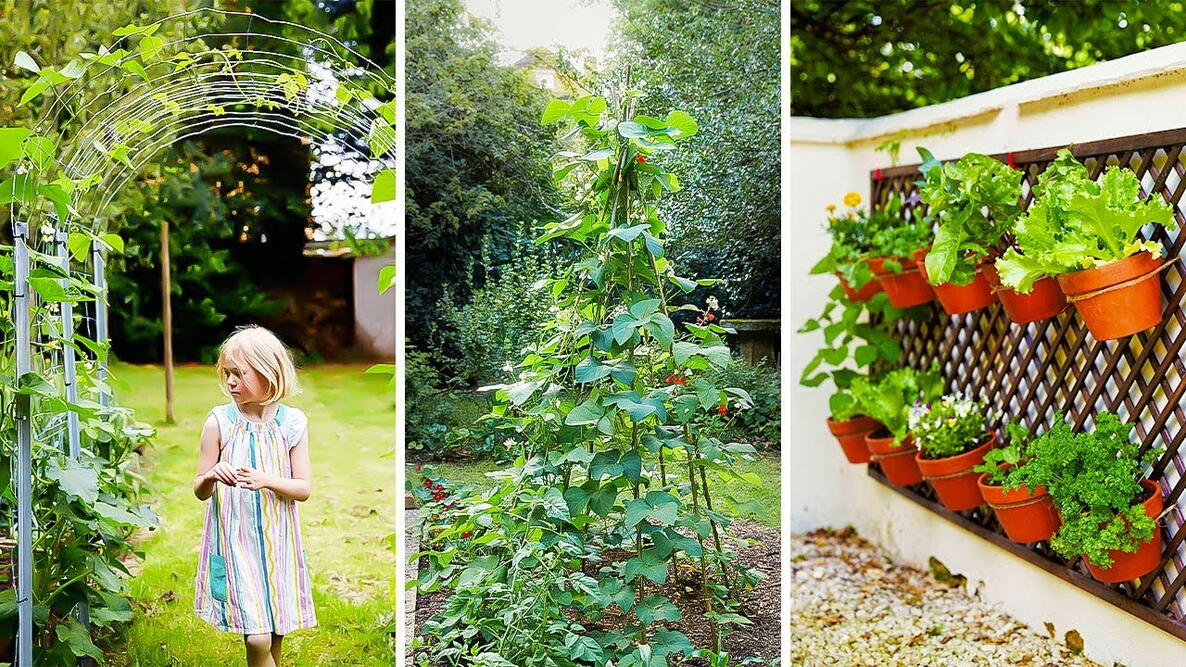Vertical Gardening:
Vertical gardening: Have you ever imagined growing a lush garden without needing a spacious backyard? Well, with vertical gardening, you can do just that! Whether you have limited space or simply want to add a unique touch to your garden, vertical gardening is an innovative and space-saving way to cultivate plants. So, let’s dive in and discover the wonders of vertical gardening together!
Picture this: instead of having plants spread out horizontally, imagine them climbing up walls, hanging from fences, or even growing on specially designed structures. Vertical gardening allows you to maximize your gardening space by using the vertical plane to create a stunning and practical green oasis. It’s like bringing a little piece of nature closer to your home, no matter how limited your space may be.
With vertical gardening, you can grow a variety of plants, from flowers and herbs to vegetables and fruits. Plus, it offers numerous benefits like improved air quality, reduced soil erosion, and increased accessibility. It’s not just about functionality, though; vertical gardens also add a visually appealing and vibrant element to any space. So get ready to transform your garden into an awe-inspiring vertical paradise! Let’s explore the world of vertical gardening and discover all the green possibilities it has to offer.

Vertical Gardening: Maximizing Your Green Space
Vertical gardening is a technique that allows you to maximize your green space by growing plants vertically, rather than horizontally. It is a popular choice for urban dwellers and those with limited garden space, as it allows them to make the most of their available area. In this article, we will explore the benefits, techniques, and tips for successful vertical gardening.
The Benefits of Vertical Gardening
Vertical gardening offers numerous benefits for both the gardener and the environment. First and foremost, it allows you to grow a wide variety of plants in a small space. By utilizing vertical structures such as walls, trellises, and hanging baskets, you can create a beautiful and productive garden even in the smallest of areas.
Another advantage is that vertical gardening helps maximize sunlight exposure. By arranging your plants vertically, you can ensure that each one receives sufficient sunlight, promoting healthy growth and higher yields. Additionally, vertical gardening can improve air circulation, reducing the risk of diseases and pests.
Furthermore, vertical gardening has environmental benefits. It can help mitigate urban heat island effects by providing shade and cooling the surrounding area. It also contributes to air purification and noise reduction. Additionally, growing your own vertical garden enables you to produce your own food, reducing your carbon footprint and promoting sustainable living.
Techniques for Successful Vertical Gardening
To create a successful vertical garden, you need to choose the right plants, structures, and techniques. Here are some key considerations:
1. Plant Selection: Opt for plants that are suitable for vertical growth, such as climbers, vines, and compact varieties. Choose plants with similar sunlight and water requirements to ensure optimal growth.
2. Structure Selection: Determine the type of vertical structure that best suits your space and desired aesthetic. This could include trellises, arbors, wall-mounted planters, or hanging baskets. Consider the weight-bearing capacity of your chosen structure.
3. Soil and Drainage: Use lightweight potting soil that provides good drainage to prevent waterlogged roots. Add compost or organic matter to enhance fertility and moisture retention.
4. Irrigation: Install an efficient irrigation system that delivers water directly to the roots of your plants. Drip irrigation or self-watering containers are excellent options for vertical gardens.
5. Maintenance: Regularly prune and trim your plants to encourage healthy growth and prevent overcrowding. Monitor soil moisture levels and adjust watering accordingly. Remove weeds and pests promptly to maintain a thriving vertical garden.
Tips for Successful Vertical Gardening
Here are some additional tips to help you make the most of your vertical garden:
1. Consider the Microclimate: Assess the lighting, temperature, and wind conditions of your vertical gardening area. Choose plants that are well-suited to the microclimate to optimize their growth and health.
2. Use Companion Planting: Integrate companion plants that provide mutual benefits. For example, plant aromatic herbs to repel pests or include flowers that attract pollinators to enhance fruit and vegetable production.
3. Provide Support: As plants grow vertically, they may require additional support. Install trellises, plant ties, or cages to ensure that they stay upright and avoid damage from wind or heavy rainfall.
4. Regularly Feed Your Plants: Apply organic fertilizer or compost to provide essential nutrients for your plants’ growth. Follow the recommended dosage and frequency for each specific plant.
5. Rotate Your Crops: Avoid planting the same crops in the same location year after year to prevent nutrient depletion and minimize the risk of diseases or pests. Practice crop rotation to maintain healthy soil and plant vitality.
By following these techniques and tips, you can create a stunning vertical garden that not only optimizes your green space but also adds beauty and productivity to your surroundings. Embrace vertical gardening and experience the joy of growing your own garden, no matter how small your available space may be.
1. Utilizing Old Ladders as Vertical Gardens
Old ladders can be repurposed to create vertical gardens with a unique flair. Simply lean the ladder against a wall or fence, and secure planters or hanging baskets on each rung. Fill the planters with your favorite flowers, herbs, or succulents. This creative approach not only adds greenery to your space but also provides an interesting visual element.
2. Vertical Gardening for Small Balconies
If you have a small balcony, vertical gardening can be a game-changer. Attach wall-mounted planters or hanging baskets to railings or walls. Opt for compact plants like cherry tomatoes, strawberries, or trailing ivy. This way, you can enjoy fresh produce or vibrant foliage without sacrificing precious floor space.
3. Creating a Living Wall
Living walls, also known as green walls or vertical gardens, are an innovative way to bring nature indoors. Cover a wall with a series of modular planting pockets or vertical planters. Choose a mix of vibrant and lush plants to create a breathtaking display of foliage. Living walls not only add aesthetic appeal but also improve air quality and create a calming ambiance.
By exploring these creative vertical gardening ideas, you can unleash your inner creativity and transform your space into a flourishing oasis of greenery. With a little imagination and the right plants, you can create a stunning vertical garden that reflects your unique style and enhances your surroundings.
Key Takeaways: Vertical Gardening
- Vertical gardening is a technique of growing plants in a limited vertical space.
- It is perfect for small gardens, balconies, and even indoor spaces.
- Vertical gardening maximizes space efficiency and allows for better plant organization.
- By utilizing trellises, hanging baskets, and vertical structures, plants can grow vertically instead of horizontally.
- Vertical gardening provides easy access for maintenance and harvesting, reducing strain on the back.
Frequently Asked Questions
Welcome to our Frequently Asked Questions section on vertical gardening! If you’re interested in maximizing your gardening space and growing plants vertically, you’ve come to the right place. Below are some common questions people have about vertical gardening and their answers. Let’s dive in!
1. Can I grow any type of plant vertically?
Vertical gardening offers great versatility, allowing you to grow a variety of plants. However, it’s important to consider the specific needs of each plant. Some plants, like tomatoes and cucumbers, thrive in vertical gardens due to their upward growth habit. Others, like root vegetables, might not be the best fit as they require more space and soil depth. Herbs, flowers, and leafy greens are generally well-suited for vertical gardening. Research the plants you’re interested in and choose ones that will thrive in your vertical garden.
Keep in mind that certain plants may require additional support or trellising as they grow vertically. Understanding the requirements of the plants you choose will help you create a successful vertical garden.
2. Do I need a special structure or equipment for vertical gardening?
While there are specialized vertical gardening structures and equipment available, you don’t necessarily need them to get started. One of the simplest ways to create a vertical garden is by utilizing existing structures like walls, fences, or even tall planters. You can also repurpose everyday items such as pallets or old bookshelves to create vertical growing spaces.
If you want a more tailored approach, vertical gardening kits and systems are available for purchase. These often come with built-in support structures, irrigation systems, and containers designed specifically for vertical gardening. They can provide convenience and efficiency, especially for beginners. Ultimately, the choice of equipment or structure depends on your budget, available space, and personal preferences.
3. How do I ensure proper watering in a vertical garden?
Watering is a crucial aspect of vertical gardening as water may drain faster due to the vertical orientation. To ensure proper hydration, there are a few strategies you can employ. First, choose a growing medium or soil that retains moisture well. This can help prevent excessive water loss. Next, consider using an irrigation system designed for vertical gardens, such as a drip irrigation system. These systems deliver water directly to the plant roots, minimizing wastage and ensuring efficient watering.
Regular monitoring is essential to determine the watering needs of your vertical garden. Check the moisture level of the soil regularly and adjust watering accordingly. It’s better to water deeply and less frequently to encourage plants to establish stronger roots. Remember to factor in environmental conditions, such as temperature and humidity, which can influence the water requirements of your plants.
4. Are there any specific maintenance requirements for vertical gardens?
Like any other garden, vertical gardens require regular maintenance to thrive. Here are a few key maintenance tasks to keep in mind. First, monitor the plants for any signs of pests or diseases and take appropriate action. Inspect the structure supporting your vertical garden to ensure stability and make any necessary repairs. Pruning is also important to promote healthy growth and prevent overcrowding.
Regular fertilizing is crucial for providing necessary nutrients to your plants. Consider using slow-release fertilizers or organic materials like compost. Finally, keep an eye on the overall health of your plants and be prepared to make adjustments. Some plants may outgrow their allotted space and need to be relocated or replaced. By staying proactive and tending to your vertical garden regularly, you can enjoy a flourishing, beautiful display of plants.
5. Can vertical gardening be done indoors?
Absolutely! Vertical gardening can be done indoors as well as outdoors, making it a versatile option for those with limited outdoor space or living in apartments. To create an indoor vertical garden, you’ll need to consider factors such as lighting, temperature, and humidity. Choose plants that thrive in indoor conditions, such as pothos, spider plants, or herbs like basil or mint.
Ensure your indoor vertical garden receives adequate light, either through natural sunlight or artificial grow lights. Pay attention to the temperature and humidity levels in the room and adjust them to suit the needs of your plants. Indoor vertical gardens can enhance the aesthetics of your home while bringing nature indoors, providing a unique and appealing gardening experience.

Planting a Vertical Strawberry Garden! 🍓🙌😍
Summary
Vertical gardening is a cool way to grow plants without needing a lot of space. By using walls or structures, you can create a beautiful garden that goes up instead of out. It’s great for growing plants like herbs and veggies, and it can make your space feel more green and fresh.
The key to vertical gardening is choosing the right plants and giving them what they need to thrive in their new vertical homes. Make sure to pick plants that can grow in smaller spaces and provide them with enough sunlight, water, and nutrients. With some creativity and care, you can have a thriving garden that adds beauty and freshness to any space.
